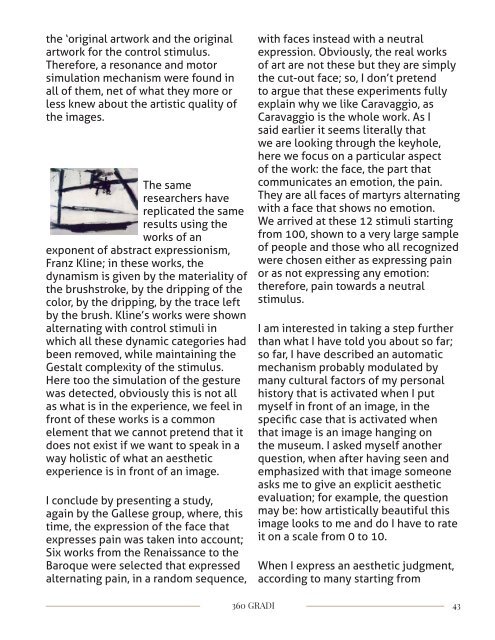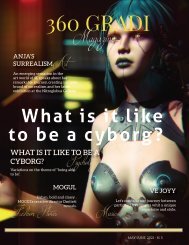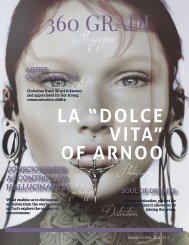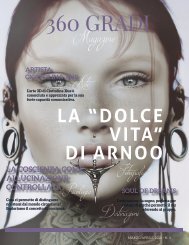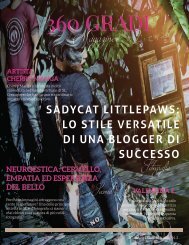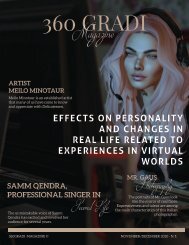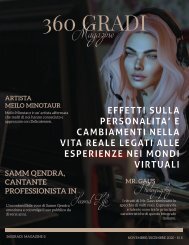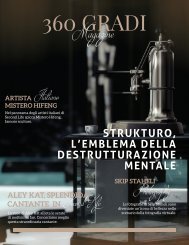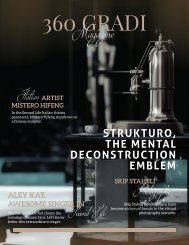360 GRADI MAGAZINE January/February 2021
The January/February 2021 issue of 360GRADI Magazine is online! All updates on our Fan Page: https://www.facebook.com/360gradisecondlifesionisti Don't forget to take our kiosk to put in your land! You won't miss an issue and you'll give a useful service to your visitors for free. Take your kiosk: http://maps.secondlife.com/secondlife/Petopia/217/216/4087 360 GRADI Magazine is the trendy, elegant, refined, and sophisticated publishing about Second Life (the virtual world by Linden Lab). Out every two months.
The January/February 2021 issue of 360GRADI Magazine is online!
All updates on our Fan Page: https://www.facebook.com/360gradisecondlifesionisti
Don't forget to take our kiosk to put in your land! You won't miss an issue and you'll give a useful service to your visitors for free.
Take your kiosk: http://maps.secondlife.com/secondlife/Petopia/217/216/4087
360 GRADI Magazine is the trendy, elegant, refined, and sophisticated publishing about Second Life (the virtual world by Linden Lab).
Out every two months.
Create successful ePaper yourself
Turn your PDF publications into a flip-book with our unique Google optimized e-Paper software.
the ‘original artwork and the original<br />
artwork for the control stimulus.<br />
Therefore, a resonance and motor<br />
simulation mechanism were found in<br />
all of them, net of what they more or<br />
less knew about the artistic quality of<br />
the images.<br />
The same<br />
researchers have<br />
replicated the same<br />
results using the<br />
works of an<br />
exponent of abstract expressionism,<br />
Franz Kline; in these works, the<br />
dynamism is given by the materiality of<br />
the brushstroke, by the dripping of the<br />
color, by the dripping, by the trace left<br />
by the brush. Kline’s works were shown<br />
alternating with control stimuli in<br />
which all these dynamic categories had<br />
been removed, while maintaining the<br />
Gestalt complexity of the stimulus.<br />
Here too the simulation of the gesture<br />
was detected, obviously this is not all<br />
as what is in the experience, we feel in<br />
front of these works is a common<br />
element that we cannot pretend that it<br />
does not exist if we want to speak in a<br />
way holistic of what an aesthetic<br />
experience is in front of an image.<br />
I conclude by presenting a study,<br />
again by the Gallese group, where, this<br />
time, the expression of the face that<br />
expresses pain was taken into account;<br />
Six works from the Renaissance to the<br />
Baroque were selected that expressed<br />
alternating pain, in a random sequence,<br />
with faces instead with a neutral<br />
expression. Obviously, the real works<br />
of art are not these but they are simply<br />
the cut-out face; so, I don’t pretend<br />
to argue that these experiments fully<br />
explain why we like Caravaggio, as<br />
Caravaggio is the whole work. As I<br />
said earlier it seems literally that<br />
we are looking through the keyhole,<br />
here we focus on a particular aspect<br />
of the work: the face, the part that<br />
communicates an emotion, the pain.<br />
They are all faces of martyrs alternating<br />
with a face that shows no emotion.<br />
We arrived at these 12 stimuli starting<br />
from 100, shown to a very large sample<br />
of people and those who all recognized<br />
were chosen either as expressing pain<br />
or as not expressing any emotion:<br />
therefore, pain towards a neutral<br />
stimulus.<br />
I am interested in taking a step further<br />
than what I have told you about so far;<br />
so far, I have described an automatic<br />
mechanism probably modulated by<br />
many cultural factors of my personal<br />
history that is activated when I put<br />
myself in front of an image, in the<br />
specific case that is activated when<br />
that image is an image hanging on<br />
the museum. I asked myself another<br />
question, when after having seen and<br />
emphasized with that image someone<br />
asks me to give an explicit aesthetic<br />
evaluation; for example, the question<br />
may be: how artistically beautiful this<br />
image looks to me and do I have to rate<br />
it on a scale from 0 to 10.<br />
When I express an aesthetic judgment,<br />
according to many starting from<br />
<strong>360</strong> <strong>GRADI</strong><br />
43


